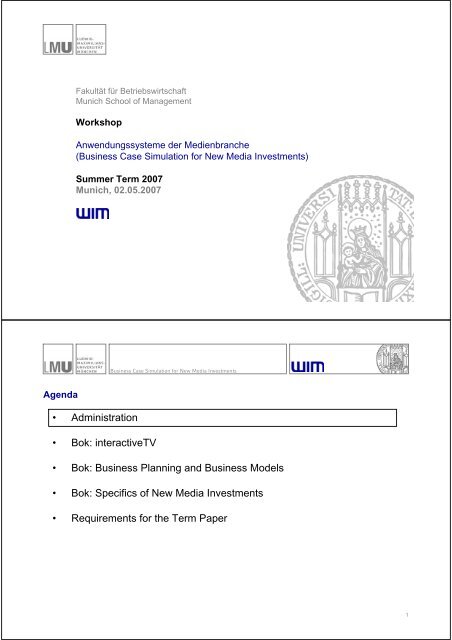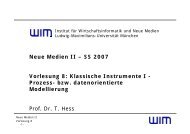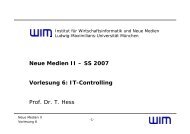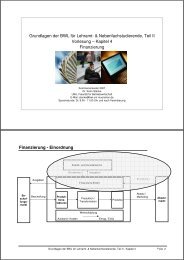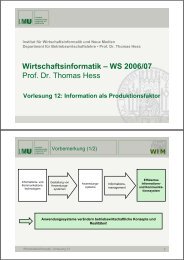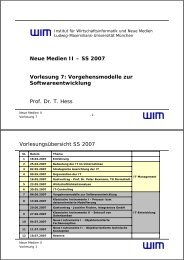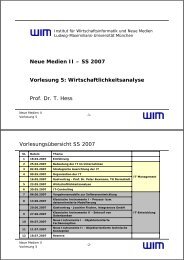Business Planning and Business Models • Bok
Business Planning and Business Models • Bok
Business Planning and Business Models • Bok
Create successful ePaper yourself
Turn your PDF publications into a flip-book with our unique Google optimized e-Paper software.
Fakultät für BetriebswirtschaftMunich School of ManagementWorkshopAnwendungssysteme der Medienbranche(<strong>Business</strong> Case Simulation for New Media Investments)Summer Term 2007Munich, 02.05.2007<strong>Business</strong> Case Simulation for New Media InvestmentsAgenda• Administration• <strong>Bok</strong>: interactiveTV• <strong>Bok</strong>: <strong>Business</strong> <strong>Planning</strong> <strong>and</strong> <strong>Business</strong> <strong>Models</strong>• <strong>Bok</strong>: Specifics of New Media Investments• Requirements for the Term Paper1
<strong>Business</strong> Case Simulation for New Media InvestmentsExpected use of BoKDescriptionof theBody ofKnowledge (BoK)Solving practical issues byusing the BoKExplanation ofcircumstances by using theBoKExtend the BOK Objectives <strong>and</strong> Key Learnings of the Seminar2<strong>Business</strong> Case Simulation for New Media InvestmentsObjectives <strong>and</strong> Key Learnings of the Seminar• Conceptional examination with selected aspects of management in media businesses.• Break down of an abstract problem of a model.• Additional analysis with simulation models.• Acquisition of basic principles of scientific working which are necessary for writing a diplomathesis.• Practice of teamwork in case studies.3
<strong>Business</strong> Case Simulation for New Media InvestmentsAgenda• Administration• <strong>Bok</strong>: interactiveTV• <strong>Bok</strong>: <strong>Business</strong> <strong>Planning</strong> <strong>and</strong> <strong>Business</strong> <strong>Models</strong>• <strong>Bok</strong>: Specifics of New Media Investments• Requirements for the Term Paper6<strong>Business</strong> Case Simulation for New Media InvestmentsDefinition Interactivity, Interactivity on TVThe level of interactivity describes the dimension in which in a processof the exchange of information each new information is influenced bythe former process of exchange of information.Source: Rafaeli (1997)The level of interactivity describes the possibility of the viewer tocontrol his/her individual program. Interactivity enables the viewer toinfluence the running program <strong>and</strong> to individualize it within a particularframework.Source: Bornemann (2004)7
<strong>Business</strong> Case Simulation for New Media InvestmentsLevels of InteractivityLevelDescriptionFeedbackChannelnecessaryCluster of interactive media productsLevel 0Switch on/off, changeprogramNoLevel 1Level 2Choice of time <strong>and</strong> mediaby the userAdditional informationNoYes„on-dem<strong>and</strong>“call of storedcontentLevel 3Level 4Level 5Individual dem<strong>and</strong> ofcontent, passive userguidanceCommunicative, pathdependentinteractionUser generated contentYesYesYesIntegration ofthe user intothe progressof the actionExchange ofuser generatedcontentSource: see Schrape (1995)8<strong>Business</strong> Case Simulation for New Media InvestmentsForms of interactiveTV• (linear TV)• Continuous flow of program• Possibility to switch on <strong>and</strong> off or to change the program• parallel TV:• Supplier uses several channels to broadcast synchronised channels• Viewer can choose between these channels• Examples: Change of perspectives or commentator• additive TV:• Dem<strong>and</strong> of data in parallel to the television picture• Examples: One-way-services like teletext, EPGs• on-dem<strong>and</strong> TV:• Flexible dem<strong>and</strong> of stored content, „lean-back“ viewer• H<strong>and</strong>ling of transactions without media disruptions• Examples: interactive advertising, teleshopping without media disruptions• communicative TV:• Dialog-services, „lean-forward“ viewer• Examples: interactive games, chat-rooms, quiz, games, bettingSource: Bornemann (2004)9
<strong>Business</strong> Case Simulation for New Media InvestmentsExamples for iTV-Applications< > = BlätternO = In den WarenkorbO = LineupO = Mehr InformationenO = Optionen anzeigen14<strong>Business</strong> Case Simulation for New Media InvestmentsAgenda• Administration• <strong>Bok</strong>: interactiveTV• <strong>Bok</strong>: <strong>Business</strong> <strong>Planning</strong> <strong>and</strong> <strong>Business</strong> <strong>Models</strong>• <strong>Bok</strong>: Specifics of New Media Investments• Requirements for the Term Paper15
<strong>Business</strong> Case Simulation for New Media InvestmentsA Promising Idea Should Meet 4 CharacteristicsExplicit CustomerValueSufficiently SizedMarketFeasibility &ProfitabilitySatisfactory Levelof InnovationSource: MBPW H<strong>and</strong>buch p. 918<strong>Business</strong> Case Simulation for New Media InvestmentsExplicit Customer ValueExplicit CustomerValueSufficient SalesMarket SizeFeasibility &ProfitabilitySatisfactory Levelof Innovation19
<strong>Business</strong> Case Simulation for New Media InvestmentsCustomer Value Has 3 DimensionsTimeQualityCostCustomer value can beexpressed in EUR: willingnessto pay for the productCustomer value is•An important parameter to estimate the upper price ceiling•The first hurdle for your Idea to estimate dem<strong>and</strong>s•A proof of concept of the business model20<strong>Business</strong> Case Simulation for New Media InvestmentsSufficient Sales Market SizeExplicit CustomerValueSufficient SalesMarket SizeFeasibility &ProfitabilitySatisfactory Levelof Innovation21
<strong>Business</strong> Case Simulation for New Media InvestmentsPorter’s 5 Forces Offer a Framework to Assess Market Forces5 forces to analyze micro environment:PEST analysis of macro environment:EnvironmentLegends <strong>and</strong> colors are helpfulto label the different forces <strong>and</strong>indicate the assessment of therespective force, e.g.° assessment+ good for the industry- negative for the industryPoliticalEconomicSocialTechnological26<strong>Business</strong> Case Simulation for New Media InvestmentsFeasibility & ProfitabilityExplicit CustomerValueSufficient SalesMarket SizeFeasibility &ProfitabilitySatisfactory Levelof Innovation27
<strong>Business</strong> Case Simulation for New Media InvestmentsFeasibility has 4 DimensionsTechnicalFeasibilityIs the product practicable?FeasibilityLegalFeasibilityMarket-sidedFeasibilityIs the product legal?Are any property rights infringed?Is there a competing st<strong>and</strong>ard?How do competitors react?Economic feasibilityis the 5th dimensionwhich is addressedin terms of customervalue <strong>and</strong> marketattractiveness(potential sales)SocialFeasibilityIs the product socially accepted?Only if feasibility can be answered with YES on all Dimension, it is worth to move on!28<strong>Business</strong> Case Simulation for New Media Investments2 Strategies to Reach Differential Returns <strong>and</strong> create a Profitable <strong>Business</strong>2 viable strategies to align the businessCustomer lifetime value as measure forprofitabilityRevenue/Customer25 Euro35 Euro40 Euro45 Euro10 Eurot 0 t 1 t 2 t 3 t 4time15 Euro 25 Euro 25 Euro 25 Euro 25 EuroCost/Customer• Product design or technologyadvantage• Operating efficiencies• Scale economies• Product differentiation• Product/channel mix• Niche position29
<strong>Business</strong> Case Simulation for New Media InvestmentsSatisfactory Level of InnovationExplicit CustomerValueSufficient SalesMarket SizeFeasibility &ProfitabilitySatisfactory Levelof Innovation30<strong>Business</strong> Case Simulation for New Media InvestmentsHow to Acquire Innovation AnnuitiesIs the idea really new / unique?Level ofInnovationIf „yes“Can others easily copy it?If „yes“Is it possible to trademark my idea?Own use in new products / processesMethods to turnIdeas into CashExclusion of others from the useLicensing / exchange / sale (direct returns from transfers)Free transfers (indirect returns)31
<strong>Business</strong> Case Simulation for New Media InvestmentsSpecifics of the ProductsContentContentMediumMediumConventionalMedia ProductsDigitalMedia Products36<strong>Business</strong> Case Simulation for New Media InvestmentsCase: Holtzbrinck <strong>and</strong> studiVZIn 2007, Holtzbrinck, a leading publisher in Germany (H<strong>and</strong>elsblatt, Zeit), buys for 85 million EurostudiVz, a community plattform for students. studiVZ has 1 million user (students <strong>and</strong> graduates) 300.000 groups of interest in Germany, France, Pol<strong>and</strong>, Spain <strong>and</strong> Italy. Directly payment of 50 million for the founders Additional payment of 35 millions depends on expected developments Other competitors bit higher, but Holtzbrinck was member of the supervisory board.Objectives of Holtzbrinck: Turnaround with studiVZ Similar success like the U.S. equivalent “Facebook” – 50$ million sales Synergies with the student guide of the weekly journal “Zeit“, the journal “Zeit Campus“ <strong>and</strong> thecorresponding online-plattform.37
<strong>Business</strong> Case Simulation for New Media InvestmentsCase: Holtzbrinck <strong>and</strong> studiVZ – Problems with the Acquisition Profitability – How to earn money with students? Management mistakes (studiVZ) Problems with the IT-infrastructure Attacks of hacking Problems with privacy policies Reputation loss Amount of synergies are fuzzy38<strong>Business</strong> Case Simulation for New Media InvestmentsInstrumentsInstruments for Profitability Analysis of Information SystemsClassic ProceduresNewer ProceduresOne- <strong>and</strong> littledimensionalProceduresMultidimensionalProceduresStaticProceduresDynamicProceduresEspeciallyvalue orientedSelection of thebest alternativeComparative CostMethodProfit ComparisonMethodNPV Method“Annuitäten”-MethodValueanalysisUtilityanalysisFunctional ChainAnalysisHedonic-WageApproachAverage ReturnMethodInternal Rate ofReturn MethodKey-Data MethodAmortisationMethodTotal Cost ofOwnershipSource: Gehra 200539
<strong>Business</strong> Case Simulation for New Media InvestmentsPresent ValueThe most commonly applied model of the time value of money is compound interest. To acompany which who has the opportunity to invest an amount of money C for t years at a rate ofinterest of i compounded annually, the present value of the receipt of C, t years in the future, is:C t = C(1 + i) -t = C /(1+i) tDepending on your case, think about using continuous compounding interest!40<strong>Business</strong> Case Simulation for New Media InvestmentsOther concept to review new media investments – Portfolio MethodValue losspoints1100suport for the obejctive:Improvement of the content supplychain0-5012M 11M 22303M 1-25 50Mio. €support for the objective:Higher rentability of the establishedjournals/ cross media sales3Value raise13202quality increasequalityreductionlegend:The diameter of a cricle shows thetotal cost of a projectThe figure in the circle shows theestimated risk of the investmentproject:0: low; 1: medium; 2: high; 3:highlyM marks projects, which arerequisited41
<strong>Business</strong> Case Simulation for New Media InvestmentsOther concept to review new media investmentsrisk benfits strategy fit business process fit• project period• Project volume• available resources• profitability• period of use• customerorientation• orientation oncompetitors• internal integration• requirements• dimensions ofproblems• dependency• non measurablebenefits• synergies• potentialdevelopments• process orientation• afficiency of theackquisiton• Objectives <strong>and</strong>resonsibilities42<strong>Business</strong> Case Simulation for New Media InvestmentsOther concept to review new media investmentslowproject-portfoliosourrounding-portfoliohighriskACBstrategyfitBAhighlowbenefitshighconsolidationClowlowhighbusiness process fitaggregated-portfoliohighBprofitabilityCAlowlowfithigh43
<strong>Business</strong> Case Simulation for New Media InvestmentsCosts- Measuring <strong>and</strong> estimation of costs is difficult- Problem: New technologies or content could be inappropriate to existing systems or informationsystem/ content allocation infrastructure- The adaptation would cause more cost than expected- Opportunity Costs: For example WAP is a st<strong>and</strong>ard which a lot of publishing companies use formobile user.What would happen, if the st<strong>and</strong>ard wouldn´t be as established as actually planned? Or a newst<strong>and</strong>ard would be developed <strong>and</strong> your company has decided to invest in the wrong st<strong>and</strong>ard?- Uncertainty of the future technological development could waste a lot of money <strong>and</strong> couldcause companies to declare bankruptcyHD-DVD vs. BlueRay?44<strong>Business</strong> Case Simulation for New Media InvestmentsBenefits- Internal problems: Exact measures or estimations of synergies are impossible. Internalprocesses are to complicated to imagine the structure alignment of the introduction of newtechnologies.- External problems:- Especially the estimation of customers behavior <strong>and</strong> the user acceptance of new productsor content is very difficult.- Other companies are able to adopt your business model Think about unique solutions, which are difficult to adopt, e. g. Apple.- Otherwise: Establishing a proprietary st<strong>and</strong>ard or a br<strong>and</strong> leads to competitive advantage, e. g.Adobe PDF, Focus Online <strong>and</strong> Focus TV.45
<strong>Business</strong> Case Simulation for New Media InvestmentsSpecifics of New Media Investments - Conclusions- Use the different approaches carefully!- Think also about future costs <strong>and</strong> benefits- Refine your approach by risk-adjustments- Do not underestimate the cost or overestimate the benefits!!!( New Economy?) Use Simulation for getting a better impression on the impact of any critical success factor ofyour business model extension46<strong>Business</strong> Case Simulation for New Media InvestmentsAgenda• Administration• Introduction: interactiveTV• Introduction: <strong>Business</strong> <strong>Planning</strong> <strong>and</strong> <strong>Business</strong> <strong>Models</strong>• Specifics of New Media Investments• Requirements for the Term Paper47
<strong>Business</strong> Case Simulation for New Media InvestmentsRequirements for the Term Paper (1)Through iTV-technologies new content <strong>and</strong> revenue models for companies of the televisionsector become possible.In the term paper the case of an existing teleshopping company has to be analyzed which istesting selected possibilities of a related diversification of offerings.In phase I economically <strong>and</strong> technically sensible alternatives are presented <strong>and</strong> a first profitabilityanalysis is conducted.In phase II the profitability analysis of a selected alternative is further examined by means ofsimulation models <strong>and</strong> the result of phase I is specified.Finally the results <strong>and</strong> the argumentation are summed up in a recommended course of action.48<strong>Business</strong> Case Simulation for New Media InvestmentsRequirements for the Term Paper (1)• The case is examined by four groups with 3 students each. Each group takes one form ofoffering:• Education-TV (Edutainment)• Music-TV• Travel-TV• Videogame-TV• Sport-TV• The result has to be presented in a 25-page paper. It is absolutely necessary that the requiredformalities (see website) are considered.• The table of contents has to be cleared with the assistant within 14 days.49
<strong>Business</strong> Case Simulation for New Media InvestmentsExample – Bonus-Points-System of TeleshoppingCost- <strong>and</strong>SupplymodelProduction ModelReturn- <strong>and</strong>distributionmodelService-offering ModelPartial OfferSupplierDeliveryPaymentTaskTask……Task……•…Partial Offer•…Partial Offer•…Integrated Product /Service OffersDeliveryPaymentCustomerSource: Wirtz, B.W. (2005): Medien- und Internetmanagement50<strong>Business</strong> Case Simulation for New Media InvestmentsExample „Project: Bonus-Points“Beschreibung t0 t1 t2KOSTEN• A teleshopper plans to give a 10€voucher to each purchaser inDecember throughout the next years,thereby hoping to stimulate additional(Christmas-) purchases.• Questions• How likely is it that a positive NPVis achieved ?• How many customers have to takepart at the program in order toachieve a positive NPV ?• …Fixe KostenIT-Anpassung € 50.000,00 € - €-Marketing&Promotion € 50.000,00 € 30.000,00 € 30.000,00Projekt-Controlling € 10.000,00 € 7.000,00 €7.000,00Fixe Kosten 110.000 € 37.000 € 37.000 €Variable KostenDruck & Porto € 36.000 € 39.000 €41.400Sachbearbeiter (Service) € 6.000 € 6.000 €7.500Gutscheinwert € 540.000 € 585.000 €621.000ErstkaufKosten der Warenabgabe € 360.000 € 390.000 €414.000Kosten des Wareneinkaufs € 1.680.000 € 1.820.000 € 1.932.000ZweitkaufKosten der Warenabgabe € 324.000 € 351.000 €372.600Kosten des Wareneinkaufs € 1.512.000 € 1.638.000 € 1.738.800NeukundenKosten der Warenabgabe € 75.000 € 60.000 €45.000Kosten des Wareneinkaufs € 350.000 € 280.000 €210.000Variable Kosten 4.883.000 € 5.169.000 € 5.382.300 €ERLÖSEParameter / Assumptions t0 t1 t2Gutschein-Wert € 10,00Anreizwirkung bei Altkunden Teilnehmende Kunden 60.000 65.000 69.000Erlöse bei erstem Kauf Neukunden € pro Periode 2.400.000 € 2.600.000 5.000 € 4.000 2.760.000 3.000Erlöse bei zweitem KaufAktivierte € Kunden Erstkauf 2.160.000 € 2.340.000 40% € 2.484.000Aktivierung Zweitkauf/Einlösung 90%Neukunden-Käufe Porto und € umgelegte Druckkosten 500.000 € € 400.000 0,60 €300.000Beschwerdequote 15%Erlöse Beschwerden je Mitarbeiter 5.060.000 € 5.340.000 2.500 € 5.544.000 €Monatslohn Mitarbeiter € 1.500,00Ergebnis Durchschnittlicher Bestellwert 67.000 € € 134.000 100 € 124.700 €Einkaufspreis in % vom Bestellwert 70%Durchschnittliche Transaktionskosten € 1551
<strong>Business</strong> Case Simulation for New Media InvestmentsExample – A ResultWith a Likelihood of 63% the Project has positive NPV (Net PresentValue).52<strong>Business</strong> Case Simulation for New Media InvestmentsTable of Contents• Phase I (Paper)• Basics/Object of Investigation (short)- market overview- present business model + classification- new technology + classification-…• Expansion of the <strong>Business</strong> Model-conception- hypotheses about rentability <strong>and</strong> critical factors• Rough Specification of the Profitability Analysis- costs/benefits- exogene assumptions- questions for simulation model / basis for decisions• Phase II (Presentation)• Specification of the Model• Presentation of the Model <strong>and</strong> Recommended Course of ActionLieferantenLieferungVergütungLeistungserstellungsmodellAufgabeAufgabe……Aufgabe……LeistungsangebotsmodellErlös- undDistributionsmodellTeilleistungsangebot•…Teilleistungsangebot•…Integriertes Produkt-/DienstleistungsangebotTeilleistungsangebot•…Kosten- undBeschaffungsmodellLieferungErlöseBeschreibung t0 t1 t2KOSTENFixe KostenIT-Anpassung 50.000,00€ - €€ -€ 30.000,00Marketing&Promotion 50.000,00€ 30.000,00 €€ 7.000,00Projekt-Controlling 10.000,00€ 7.000,00 €37.000 €Fixe Kosten 110.000 € 37.000 €Variable KostenDruck & Porto 36.00039.00041.400€ €€€ 7.500Sachbearbeiter (Service) 6.000€ 6.000 €€ 621.000Gutscheinwert 540.000€ 585.000 €ErstkaufKosten der Warenabgabe 360.000€ 390.000 €€ 414.000€ 1.932.000Kosten des Wareneinkaufs 1.680.000€ 1.820.000 €ZweitkaufKosten der Warenabgabe 324.000€ 351.000 €€ 372.600€ 1.738.800Kosten des Wareneinkaufs 1.512.000€ 1.638.000 €NeukundenKosten der Warenabgabe 75.000€ 60.000 €€ 45.000€ 210.000Kosten des Wareneinkaufs 350.000€ 280.000 €5.382.300 €Variable Kosten 4.883.000 € 5.169.000 €ERLÖSEAnreizwirkung bei AltkundenErlöse bei erstem Kauf 2.400.0002.600.0002.760.000€ €€€ 2.484.000Erlöse bei zweitem Kauf 2.160.000€ 2.340.000 €€ 300.000Neukunden-Käufe 500.000€ 400.000 €5.544.000 €Erlöse 5.060.000 € 5.340.000 €Ergebnis 67.000 € 134.000 € 124.700 €Kunden53
<strong>Business</strong> Case Simulation for New Media InvestmentsLiterature• Hilbers/Wilde (2005): Geschäftsmodell Teleshopping - Wertschöpfung, Erfolgsfaktoren undHerausforderungen, in: Zeitschrift für Medienwirtschaft, 2/2005, S. 67-73.• Wirtz, B. (2005): Medien- und Internetmanagement, 4. Auflage, Wiesbaden.• zu Salm, C. (2004):Zaubermaschine interaktives Fernsehen?, Wiesbaden.• H<strong>and</strong>buch: Münchner <strong>Business</strong> Plan Wettbewerb: „Der optimale <strong>Business</strong>plan“http://de.mbpw.de/media.php?id=559• Brugger, R. (2005): Der IT <strong>Business</strong> Case, Berlin.• Perridon/ Steiner (2007): Finanzwirtschaft der Unternehmung, 14. Auflage.• Alternativ: Brealey/ Myers (2005): Principles of Corporate Finance, 8. Auflage.• Fahrmeir/ Künstler/ Pigeot/ Tutz (2002): Statistik. Der Weg zur Datenanalyse.• H<strong>and</strong>bücher zu Christal Ball sind im Internet verfügbar54


